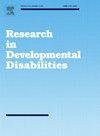Trait mindfulness in adolescents with and without Attention-Deficit/Hyperactivity Disorder
IF 2.9
2区 医学
Q1 EDUCATION, SPECIAL
引用次数: 0
Abstract
Background and objectives
Mindfulness-based interventions (MBIs) are proposed to cultivate trait mindfulness through mindfulness practice, which may in turn to lead improved clinical outcomes. Individuals who report lower levels of this trait may be promising candidates for MBIs because they present with the opportunity for growth in this area. Attention-Deficit/Hyperactivity Disorder (ADHD) has been associated with low trait mindfulness, though facets of trait mindfulness and ADHD features beyond core symptoms have not been examined among youth with the disorder. The goal of this study was to examine trait mindfulness—including facets of trait mindfulness—in adolescents with and without ADHD in relation to ADHD symptoms and related ADHD characteristics.
Methods
Adolescents (29 ADHD, 30 non-ADHD) and their caregivers completed measures of ADHD symptoms and related characteristics. Adolescents completed a trait mindfulness measure.
Results
The ADHD group scored significantly lower than the non-ADHD group in trait mindfulness. ADHD symptoms and multiple related characteristics were also inversely associated with trait mindfulness. A series of regressions controlling for sex and age indicated that trait mindfulness—particularly acting with awareness—is inversely associated with ADHD symptoms, cognitive disengagement syndrome symptoms, executive functioning, and sleep.
Conclusions
Trait mindfulness, particularly acting with awareness, is lower among adolescents with ADHD and is inversely associated with ADHD and related characteristics. Because mindfulness is thought to be particularly therapeutic for those low in trait mindfulness, findings indicate the need to develop MBIs for adolescents with ADHD.
求助全文
约1分钟内获得全文
求助全文
来源期刊

Research in Developmental Disabilities
Multiple-
CiteScore
5.50
自引率
6.50%
发文量
178
期刊介绍:
Research In Developmental Disabilities is aimed at publishing original research of an interdisciplinary nature that has a direct bearing on the remediation of problems associated with developmental disabilities. Manuscripts will be solicited throughout the world. Articles will be primarily empirical studies, although an occasional position paper or review will be accepted. The aim of the journal will be to publish articles on all aspects of research with the developmentally disabled, with any methodologically sound approach being acceptable.
 求助内容:
求助内容: 应助结果提醒方式:
应助结果提醒方式:


